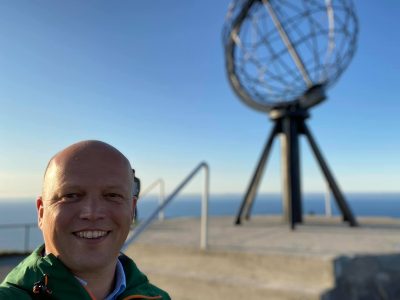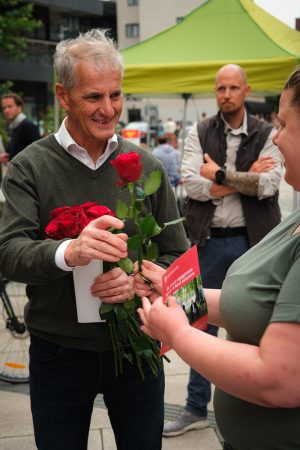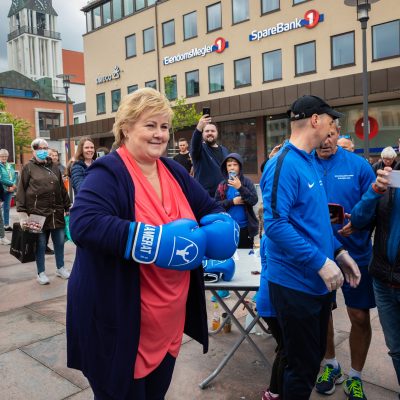NEWS ANALYSIS: Norway’s parliamentary election campaign is well underway, but voters don’t know what kind of government they’ll actually get after polls close on September 13. Public opinion polls still indicate Erna Solberg’s current Conservatives-led coalition will lose, but parties on the left-center side are quarreling and far from presenting any unified coalition of their own.

Most players are blaming what Solberg calls “left-center chaos” on a perhaps overly self-confident Center Party. It was part of the last left-center government that ruled from 2005 to 2013, led by Labour with Center and the Socialist Left (SV) as junior partners. Now polls show Center with support from more than double if not triple the voters it had in the 2017 and 2013 elections: 17.6 percent on average in July, compared to election results of 10.3 percent in 2017 and just 5.5 percent in 2013.
That’s left Center Party leader Trygve Slagsvold Vedum grinning from ear to ear, and emboldening him to now both campaign as a candidate for prime minister and, most controversially, to promote forming a government only with Labour, which currently can claim the most support of any party with 24.3 percent. Vedum and other Center leaders have repeatedly said they don’t want to rule again with SV, which is far more concerned about climate change, the environment and social differences than Center is.
Vedum raising ‘so much doubt’
A Labour/Center coalition would have to gain support from other parties nearly on an issue-by-issue basis. That prompted Vedum to further provoke potential political allies by saying his party and Labour could get support from the Conservatives and other non-socialist parties on climate, oil and immigration issues, and from SV, the Greens and even the Reds on taxes, other economic issues, decentralization and protectionism.
“That raises the question of whether you could even call such a government ‘red-green’ (or left-center), or whether it’s (just) a centrist government,” editorialized newspaper Dagsavisen last week. Or, the paper added, “even whether that could be an alternative for Labour. It raises so much doubt.”

Vedum has also been criticized for all but attacking Labour after he formally launched Center’s election campaign at the North Cape last weekend. He’s already been making lots of promises to potential voters in Northern Norway who are still unhappy about a forced merger between Finnmark and Troms counties. Vedum wants to undo many of the mergers and consolidations ushered in by Solberg’s government in an effort to improve economies of scale and public service. Vedum, often viewed as a populist, then directly accused Labour and its leader Jonas Gahr Støre of having supported what he consistently calls “centralization” of everything from police stations to hospitals around the country.
Vedum’s accusation was “unwise,” claimed several commentators but he was undaunted. “There will be some tough rounds (in any future government negotiations) over some of the things that Labour has supported,” he told news bureau NTB, especially “things” in Northern Norway. The vast region has long favoured Labour, but Center has been gaining voters there over the past two years in addition to its traditional bastions of rural support elsewhere in the country.
‘Misinforming voters’
Labour Party officials, meanwhile, defied Vedum’s criticism and claimed he’s been misinforming voters. Labour’s deputy leader Bjørnar Skjæran, who’s from Northern Norway himself, notes that Labour opposed consolidation of college studies in Nordland, for example, that it withdrew support for police reform and has budgeted more money for police than both the current government parties and Center. “I wish he (Vedum) would clarify what Center really wants to do with the police and how he’ll finance it,” Skjæran told NTB. “We can live with Labour and Center not agreeing on all issues, but there’s no reason to create disagreements where there are none.” Vedum has also been accused of creating conflicts between urban and rural residents, disparaging Oslo and other Norwegian cities as well in his promotion of more support and services for rural areas.
Few are as directly challenged by Vedum’s decision to highlight conflict over cooperation than Labour’s own prime minister candidate Støre. He’s tried to stay out of the fray, opting to emphasize Labour’s own program and positions on issues instead of going on the defensive against a potential government partner. Støre and other Labour officials still firmly back a left-center coalition of Labour, Center and SV: “We only have one plan for a government,” party secretary Kjersti Stenseng said late last week. She also rejected a proposal from the left-wing Greens Party that Labour should dump Center and team up with SV, the Greens and the Reds instead. That’s not realistic, though: The Reds, which describe themselves a a “revolutionary socialistic” party, don’t want to be in a government that supports capitalism, only influence it.

Prime Minister Erna Solberg and her government partners in the Liberal and Christian Democrats are seizing on the quarreling and uncertainty within the left-center side by promoting their own unity. Newspaper Aftenposten noted how the current coalition’s three party leaders are the only ones willing to meet the public together, as they did during a meeting last week (Vedum even refused to take part in a national radio debate with Labour and SV Friday morning). Solberg and her partners, by contrast, also presented a 10-point program for how they’d create new jobs over the next four years, along with a 261-page document detailing what they’ve accomplished during the past four years.
Few argue that Solberg and her government colleagues guided Norway well through the Corona crisis. That has not, however, boosted their re-election standings, with the Conservatives lagging Labour with just over 20 percent of the vote and neither of Solberg’s junior partners showing enough support to win more than a seat or two in Parliament. The three government parties also declined to invite their former partner, the Progress Party, to their rally after Progress withdrew from the coalition early last year. Progress’ voter support has also fallen dramtically, from 15.2 percent at the last election to just 9.9 percent now.
At least voters for either of the three non-socialist parties would have a good idea of what their preferred government would look like. That’s not so on the left-center side, even though voters arguably deserve to know what the alternatives are. Aftenposten calculated as many as 12 government alternatives at present, depending on election results. Aftenposten even cited unidentified sources within Labour as suggesting Labour may ultimately try to form a government alone. That was firmly denied by Labour officials, but Aftenposten stood by its story. In the meantime, each party campaigns for its own platform, assaulting others’ along the way until the voters cast their ballots. Then the inter-party negotiations will begin.
One thing is clear: If current poll results transform into election results, Solberg’s coalition (minus Progress) would get only 54 seats in Parliament, compared to the left-center side’s 93. Assuming Labour emerges as the largest party in the county, Støre will be expected to lead negotiations for a new left-center government based on compromises all around.
Next week, meanwhile, he and other party leaders will be meeting in the southern coastal city of Arendal for the annual political festival called Arendalsuka. It’s highlighted by a debate among the leaders of all nine parties currently represented in Parliament. The debate on Monday evening August 16 will air live on NRK, and may clarify not only election issues, but how the country ultimately will be governed.
newsinenglish.no/Nina Berglund

